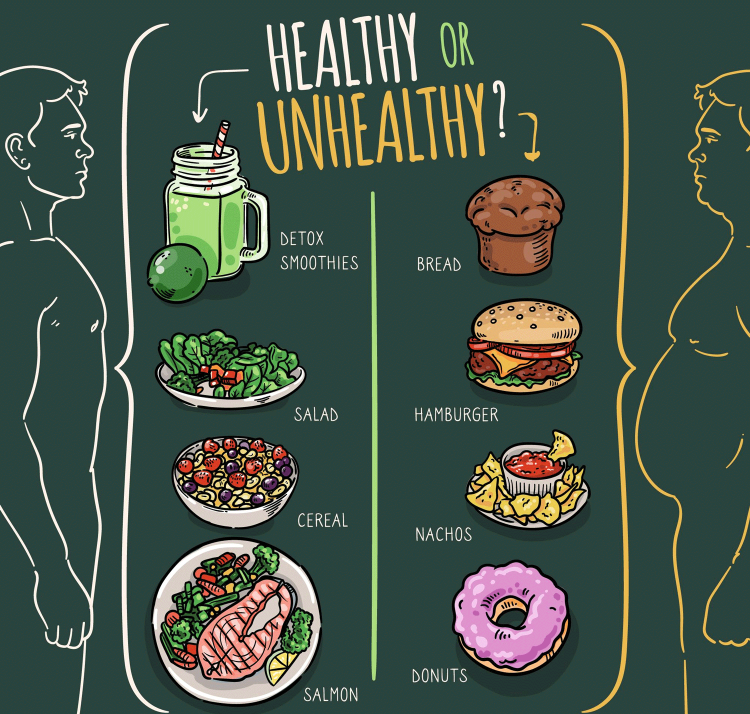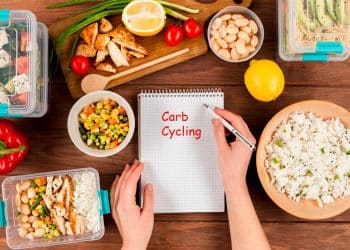As an ectomorph, I know how hard it can be to gain weight. Ectomorphs are naturally slender and tend not to gain fat or muscle easily. Ectomorphism is a beneficial trait in endurance sports, and it allows me to seemingly eat whatever I want without gaining much weight, which is often the envy of my friends and acquaintances. To discover your own body type and its impact on your fitness goals, take our Body Type Quiz and find out if you’re an Endomorph, Ectomorph, or Mesomorph.
However, being an ectomorph is a drawback in strength sports like bodybuilding and powerlifting.
That said, I’ve never let my ectomorphic tendencies stop me and have managed to gain decent amounts of muscle, once tipping the scales at a pretty solid 220 pounds. I achieved this by bulking.
Bulking involves combining a significant kilocalorie surplus with an intense weight training program to build muscle and gain weight relatively quickly. This approach comes from bodybuilding and is something many lifters do to gain mass during the off-season (1).
While bulking sounds like a straightforward process, a lot of people get it wrong and don’t get the results they expected.
As a 30-year veteran personal trainer, I’ve helped lots of my clients gain weight through bulking. I’ve also seen the mistakes that many people make. In this article, I reveal the most common bulking errors and how to avoid them.
Level Up Your Fitness: Join our 💪 strong community in Fitness Volt Newsletter. Get daily inspiration, expert-backed workouts, nutrition tips, the latest in strength sports, and the support you need to reach your goals. Subscribe for free!
The 7 Most Common Bulking Mistakes
Bulking can help you reach your muscle mass and body weight goals. However, there is a right and wrong way to go about it. Avoid these mistakes to ensure your next bulk is as safe and effective as possible.
1. Consuming Too Many Kilocalories

Bulking involves eating more food than you need to maintain your weight. This is called creating an energy or kilocalorie surplus. Your body uses this extra energy to power you through your workouts, fuel recovery, and build muscle.
Bulking diets often involve consuming anywhere from four to six thousand kilocalories per day. Needless to say, this is a huge kilocalorie surplus that all but guarantees that you’ll gain weight.
However, while an energy surplus is part and parcel of bulking, you may not need to consume that much extra food to build muscle (2). For example, if your body weight is stable at 2,000 kilocalories per day, there is no need to increase your intake to 6,000. This would be overkill.
So, while bulking does require an increase in kilocalories, you don’t need to double or triple your food intake.
Solution: Don’t just follow an off-the-peg bulking diet, as you may end up consuming far more food than you need. Instead, use a bulking calculator to customize your kilocalorie surplus. A more precise approach will save you from eating more food and gaining more fat than necessary.
2. Not Managing Your Macros
Macros, short for macronutrients, is the collective term for the protein, carbohydrates, and fats in your diet. Getting your macro mix right will help make your bulk more successful. Each macro is essential, but having too much of one and not enough of another could undermine your bulking efforts.
Protein contains amino acids, which are the building blocks of muscle. Intense training causes muscle breakdown, and you need protein to repair that damage and increase muscle mass. This is a process called muscle protein synthesis.
Consequently, you need to make sure you consume enough protein. Most experts agree that you need 1.6 to 2.0 grams of protein per kilogram of body weight for optimal muscle growth (3). Protein should make up about 30% of your daily kilocalorie intake. To easily calculate your daily protein needs for muscle growth, check out our Protein Calculator.
Carbohydrates provide your body with energy for intense training. As such, carbs should make up about 40% of your kilocalorie intake. Good sources of carbs during a bulk include rice, pasta, oats, wholemeal bread, bananas, and potatoes. These foods contain not just carbs and calories but vitamins, minerals, and fiber, all of which are critical for your health. To determine your daily recommended carbohydrate intake for optimal performance and health, try our Carbohydrates Calculator.
Fats are both a source of energy and essential for your health. Many fats are anti-inflammatory, meaning they’re good for your joints, muscles, and tendons, as well as your heart and circulatory system. Fats are also high in kilocalories, making them valuable during a bulk.
However, some fats are healthier than others, so it’s best to consume mostly natural and unrefined fats during a bulk. Good options include olive oil, full-fat dairy, oily fish, peanut butter, and other unprocessed fats. You should generally avoid refined fats like margarine and vegetable shortening.
About 30% of your bulking diet calories should come from healthy fats. To accurately calculate your daily fat intake for a balanced bulking diet, use our Fat Calculator.
Solution: Use a food-tracking app to manage your macros. Aim for a 30/40/30 ratio of protein vs. carbs vs. fats. This is the most commonly recommended macro ratio for bulking.
3. Eating Too Much Junk Food While Bulking
Many people view bulking as an opportunity to eat a lot of junk food. This is often called dirty bulking. Examples of dirty bulking foods include takeout meals, candy, ice cream, pizza, and other high-calorie processed items.
While junk food does contain plenty of kilocalories, it is usually low in the nutrients your body needs to function correctly.
Training, recovery, muscle building, and your general health are largely dependent on the nutrients in your diet. In other words, you don’t just need energy from your food; you also need things like vitamins, minerals, healthy fats, and fiber. These things are missing from most junk food.
Level Up Your Fitness: Join our 💪 strong community in Fitness Volt Newsletter. Get daily inspiration, expert-backed workouts, nutrition tips, the latest in strength sports, and the support you need to reach your goals. Subscribe for free!
Consequently, while you can include some junk food in your bulking diet, most of your meals should feature nutritious foods, including lean proteins, vegetables, whole grains, natural fats, and fruit.
Solution: Build your bulking diet around nutritious, high-calorie foods while minimizing your junk food intake. This will be better for your long-term health as well as your waistline.
4. Not Training Hard Enough
Eating more is only part of the successful bulking equation; you must also train hard and consistently. Failing to train appropriately will result in more fat than muscle gain, which defeats the point of bulking.
There is no set bulking training program, and any bodybuilding or powerbuilding workout will get the job done. However, for best results, you should follow these tried-and-tested muscle-building guidelines (4):
- Build your workouts around compound exercises
- Use progressive overload
- Hit muscle groups twice a week
- Don’t skip workouts
- Include rest days in your schedule
Solution: Bulking combines eating more with intense, consistent strength workouts, so make sure you pay as much attention to your training program as you do your diet. Check out this guide for a proven bulking program.
5. Doing Too Much Cardio
Cardio will do wonders for your fitness and health. However, some people do too much cardio during a bulk, inadvertently sabotaging their progress.
Fat gain goes hand-in-hand with bulking, but some people want to avoid increasing their body fat percentage during a bulk. Consequently, they do too much cardio. This wastes valuable energy that would be better used for strength training, recovery, and growth. It also erodes that all-important kilocalorie surplus.
While there is nothing wrong with including cardio in your bulking program, it is critical not to do too much, as you’ll make your bulk less effective.
Solution: Limit cardio to 2-3 20 to 30-minute sessions per week. This is enough to maintain or improve fitness and health without compromising muscle building and weight gain. If you are concerned about excessive fat gain, consider reducing your kilocalorie surplus.
Related: How Much Cardio is Too Much?
6. Bulking If You Are Already Overweight
While muscle gain should be your priority during a bulk, the kilocalorie surplus means that some of your extra body weight will be fat. Most people don’t need to worry about this, as you can diet that fat off at the end of your bulk with a cutting diet and workout plan.
However, bulking if you are already overweight would be a mistake. Not only will you have to diet longer to shed those unwanted pounds, but it could also harm your health.
Being severally overweight can cause numerous health issues, including (5):
- Cardiovascular disease
- Hypertension/high blood pressure
- Type 2 diabetes
- Kidney disease
- Certain cancers
- Premature death
Solution: Don’t start a bulking diet if you are already overweight. Doing so could increase your risk of developing numerous health issues or making existing problems worse. Wait until your body fat percentage is around 15% (men) or 20% (women) before considering a bulk.
7. Falling into The Perma-Bulking Trap
All good things must come to an end, and that includes bulking. There are a few ways to pick an end-point for your bulk, including:
- Hitting a target body weight, e.g., 200lbs
- Gaining a certain amount of weight, e.g., 15lbs
- Reaching a certain body fat percentage, e.g., 18%
- After a predetermined time, e.g., ten weeks
- Reaching a specific date, e.g., the end of the following month
Regardless, your bulk should have a clearly defined start and end point. This will stop you from falling into the perma-bulk trap, where your bulk never ends, and you keep gaining weight (and fat) indefinitely. Perma-bulking is bad for your health and your physique.
Perma-bulking bodybuilders are a common site in most gyms. They’re the people who are huge and strong but lack any definition or shape. That’s okay for heavyweight strongmen and powerlifters, but not the look most lifters aspire to.
Solution: Don’t start your bulk before setting an end-point. Pick a date on the calendar or a bodyweight target. Either way, make sure you know when your bulk is due to finish to avoid the perma-bulk trap.
Related: Try bulking calculator to help your weight gain / bulking journey!
Closing Thoughts
Building muscle can be a frustratingly slow process, especially for hard-gaining ectomorphs. Bulking is a proven way to accelerate your gains and achieve new levels of strength and muscularity, often in record time.
However, bulking has disadvantages, too. For example, you’ll probably gain a fair amount of body fat along with your new muscle mass, so you’ll need to follow your bulk with a suitable cutting plan if you want to look your best.
Consequently, many exercisers prefer to “lean bulk,” where they aim to minimize fat gain. This tends to be a much slower process, and your diet will need to be much more precise.
Ultimately, conventional and lean bulking strategies can work, so it’s up to you to try them both and see which you prefer. Just make sure you avoid the mistakes described in this article to make your next bulk as successful as possible.
References:
- Iraki J, Fitschen P, Espinar S, Helms E. Nutrition Recommendations for Bodybuilders in the Off-Season: A Narrative Review. Sports (Basel). 2019 Jun 26;7(7):154. doi: 10.3390/sports7070154. PMID: 31247944; PMCID: PMC6680710.
- Slater GJ, Dieter BP, Marsh DJ, Helms ER, Shaw G, Iraki J. Is an Energy Surplus Required to Maximize Skeletal Muscle Hypertrophy Associated With Resistance Training. Front Nutr. 2019 Aug 20;6:131. doi: 10.3389/fnut.2019.00131. PMID: 31482093; PMCID: PMC6710320.
- Nunes EA, Colenso-Semple L, McKellar SR, Yau T, Ali MU, Fitzpatrick-Lewis D, Sherifali D, Gaudichon C, Tomé D, Atherton PJ, Robles MC, Naranjo-Modad S, Braun M, Landi F, Phillips SM. Systematic review and meta-analysis of protein intake to support muscle mass and function in healthy adults. J Cachexia Sarcopenia Muscle. 2022 Apr;13(2):795-810. doi: 10.1002/jcsm.12922. Epub 2022 Feb 20. PMID: 35187864; PMCID: PMC8978023.
- Krzysztofik M, Wilk M, Wojdała G, Gołaś A. Maximizing Muscle Hypertrophy: A Systematic Review of Advanced Resistance Training Techniques and Methods. Int J Environ Res Public Health. 2019 Dec 4;16(24):4897. doi: 10.3390/ijerph16244897. PMID: 31817252; PMCID: PMC6950543.
- Hruby A, Manson JE, Qi L, Malik VS, Rimm EB, Sun Q, Willett WC, Hu FB. Determinants and Consequences of Obesity. Am J Public Health. 2016 Sep;106(9):1656-62. doi: 10.2105/AJPH.2016.303326. Epub 2016 Jul 26. PMID: 27459460; PMCID: PMC4981805.












